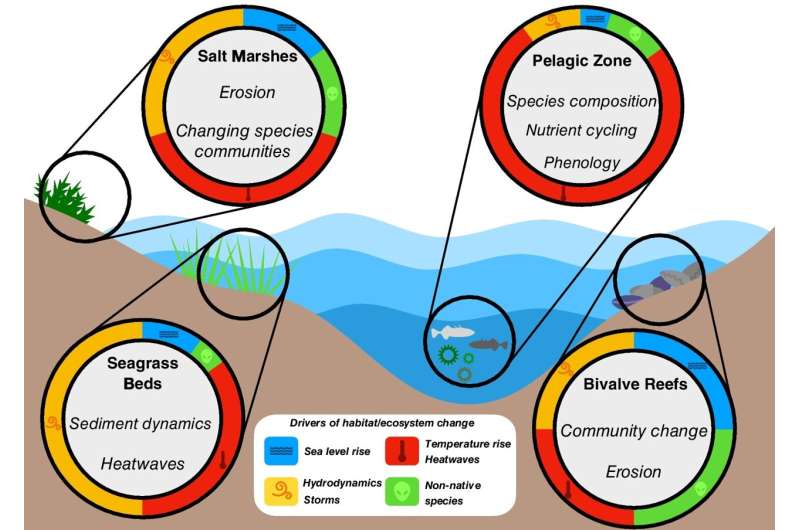This article has been reviewed according to Science X's editorial process and policies. Editors have highlighted the following attributes while ensuring the content's credibility:
fact-checked
trusted source
proofread
How climate change is transforming the Wadden Sea

Climate change can produce a range of effects on flat sedimentary coasts. Researchers from the Wadden Sea Station on Sylt have just released a multidisciplinary overview of the far-reaching climate-based changes in the Wadden Sea, a listed World Heritage Site.
The review paper in celebration of the station's centennial was published in the journal Marine Biodiversity. It covers the coastal morphology, including sediment dynamics, as well as the biology, from genetic effects to interspecies interactions, to the ecosystem level.
"Climate change is impacting the Wadden Sea at all levels: Rising temperatures and sea levels are changing the coastal morphology and sediment dynamics that have shaped the Wadden Sea for more than 8,000 years," explains Dr. Christian Buschbaum, a marine ecologist at the Wadden Sea Station on Sylt, part of the Alfred Wegener Institute, Helmholtz Center for Polar and Marine Research (AWI).
In comparison to the global ocean, the North Sea has on average warmed nearly twice as fast over the last 60 years. In this regard, mild winters and extremely high summer temperatures particularly affect the ecosystem. Heat waves, especially, with temperatures that are 3° to 5° above average, will become more frequent and last longer.
These physical changes affect the spatial extent of individual, ecologically important habitats, like seagrass meadows and mussel beds, not to mention the distribution of individual species in the water and on the seafloor. Certain species, like the cod, are particularly hard-hit, as they suffer from rising temperatures and overfishing alike.
"We're also seeing a significant increase in invasive, warmth-loving species. Though they're not (yet) a threat to native species, they are completely changing the habitat. Massive reefs of Pacific oysters and hectare-wide underwater forests of algae from the Far East can easily be spotted by anyone who visits the region," says Buschbaum, one of the study's first authors.
The Wadden Sea is of great ecological importance for many fish and bird species, like the herring, oystercatcher and knot, which use it for at least one phase of their lifecycle: it serves as a nursery and feeding ground, while also offering young fish protection from predators.
Climate warming is also affecting migration patterns; more fish are migrating farther poleward, while benthic species are withdrawing to deeper, colder waters. Those species unable to shift their distribution range are forced to adapt to the rapidly warming conditions in the Wadden Sea.
"These adaptation responses include genetic changes, but also phenotype plasticity," says Dr. Lisa Shama, the other first author. Organisms with very short generations can rapidly implement genetic changes; examples include the pathogenic vibrio bacteria which live in the invasive Pacific oyster.
"Plasticity refers to individual organisms adapting their characteristics and appearance in response to direct environmental stimuli without genetic changes taking place. As such, plasticity constitutes a more rapid response mechanism for coping with changing climatic conditions.
"Within a single generation, it can result in species appearing at changed times, like phytoplankton blooms in spring, or temperature-dependent changes in growth rates," explains Shama, an evolutionary biologist at the AWI.
Organisms can also adapt their reproductive strategies, e.g., through increased reproductive performance—like producing more eggs—to offset the young potentially lost in connection with heat stress.
In addition to these scientific highlights, the synthesis of 100 years of research at the Wadden Sea Station on Sylt above all shows how diverse and sweeping the effects of climate change on flat sedimentary coasts like the Wadden Sea are.
"Our goal was to provide a multidisciplinary overview. To make that happen, more than 30 experts from various departments in the AWI's Coastal Ecology Section joined forces and presented their findings on the effects of climate change," the authors state.
"Thanks to the multidisciplinary approach used in the study, it's become clear that climate change is affecting the Wadden Sea at all levels, causing a habitat to fundamentally change at unprecedented speed.
"This will also invariably have consequences for people living on the coast, as, e.g., coastal protection measures and tourism concepts will have to be lastingly changed.
"Consequently, pursuing an interdisciplinary approach combining the natural and social sciences is indispensable for future climate change research in the Wadden Sea in terms of developing strategies for a rapidly changing coast."
More information: Christian Buschbaum et al, Climate change impacts on a sedimentary coast—a regional synthesis from genes to ecosystems, Marine Biodiversity (2024). DOI: 10.1007/s12526-024-01453-5
Provided by Helmholtz Association of German Research Centres




















